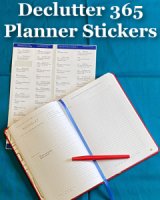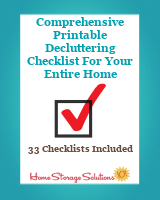
How To Eat Leftovers & Not Waste Them

One of the decluttering missions on the site is to throw away all the old food, including leftovers, that you've got in your fridge that you know you will not eat anymore.
Inevitably, when people do this mission (and when I do it for myself as well!), we begin to ponder how to eat leftovers, and not waste that food in the future.
There are so many reasons as I toss food in the trash that I feel guilty, such as that food waste costs us money, and also it isn't being a good steward of the resources we're blessed with.
That isn't meant as judgment. Trust me, I've had some containers of old leftovers that have become a science experiment that I've discovered in my fridge before. I think just about everyone has.
But I don't like it! It's gross to deal with. (Admit it -- you've thrown away a container rather than clean the yuckiness in there before! At least I know I have.)
But also for the reason I said above. I dislike that I've wasted food. It feels wrong.
So today let's explore common causes of the problem, and then work on simple steps we can take to make sure our family is eating leftovers, and we aren't throwing away food anymore.
Possible Fix: Don't Cook As Much
The first thing to consider is that perhaps you or others in your household just don't like leftovers.I don't mind eating them myself, but for example my mother will do almost anything to avoid eating them. She just doesn't like it. So for her, it's better to not have them, it's the simplest way to avoid food waste for her.
The solution for those who realize this is their problem is to cook less food for each meal.
That will require some changes to your habits, but your wallet will thank you when you are purchasing less food, and still feeding everyone!
Three Organizing Habits That Help Everyone Eat Leftovers
For the rest of us that don't mind leftovers, or even enjoy them (and the convenience of not having to cook as often when we have them), usually the problem with eating leftovers is that we're not doingHabit 1: Schedule A Consistent Time To Eat Your Leftovers
First, schedule a consistent time during the week, or every few days, that you eat leftovers.This can be consistently eating them the next day for lunch, or having a leftover night planned into the meal plan for the week regularly.
The point is to make sure you allot time to eat the food you've already prepared. This will save you money, and also time since you'll also have to cook less frequently.
Habit 2: Label & Date Food Storage Containers & Place On Leftovers Shelf In Fridge
Second, designate a specific spot in your refrigerator, either a whole shelf or part of a shelf, for leftovers, and always place those items there, and then let people know, through labels on the food containers or in some other way, what leftovers are available and how old they are.Often family members have no idea what is available, or don't know how old it is, so they're wary to eat it. Just keeping everyone informed of what is available goes a long way toward making sure the leftovers actually get eaten.
(Also make sure you're using these 5 food storage safety tips so when you and your family eat these leftovers they are safe to eat!)
Habit 3: Clean Out Your Refrigerator Of Old Leftovers Regularly
Third, to the extent that some food is not eaten, make sure you're clearing it out of the fridge regularly.The two best times to do this is the day before garbage pick up day, so the food doesn't just sit in the garbage for too long getting gross.
The other good day to do this is the day before you grocery shopping, so the fridge is clear and ready for new food when you bring it back to your home the next day.
Along with these three habits, I've gotten some really great additional tips provided by readers for how they've implemented some simple strategies to eat their leftovers.
Some of these highlighted in the article itself, plus there are even more great ideas in the comments below!
Keep A Simple List Of Leftovers Available On The Fridge

I got this tip from a reader, Susan, recently. It is so absolutely simple, but simple tips that work are the absolute best!
She sad, "I'm finding it helps to keep a list on the fridge of what leftovers, veggies, etc. need to get used up. Leftovers aren't getting lost in the back of the fridge as much."
If you don't want to use a piece of paper like I used for the illustration above, another great idea would be to use a little magnetic wipe board that you keep on the fridge where everyone can write the leftovers available, and just mark them off, or erase those words when they've been used up.
White Boards For Refrigerator {Referral Links}
So many people asked me for a printable to keep track of your leftovers that I finally created one for you. You can grab your copy here!
A reader, Jacqueline, sent in this photo below of her leftovers list in action.

Jacqueline said, "During this latest decluttering challenge of eating out of the fridge and freezer, I also found a mini-whiteboard that I had bought at Hobby Lobby. It looks like a menu board. I wrote down all the older stuff in the fridge, freezer, and pantries that I wanted to target this week and we have used up a lot. I wipe the items off as they are used. I think I will keep doing this to remind myself (and other cooks as my kids help) of the priority foods (expiration dates coming up, leftovers) to use up."
Label Leftover Containers So You Know What Is Available To Eat

I already mentioned above that labeling leftovers containers was one of the best ways to actually make sure someone in your household eats them.
Then, I got this photo above, that was sent in by a reader, Karen, who implemented this strategy with great success, so I wanted to feature it here in the article.
Karen said, "What a difference a year makes! Thank you Taylor! Last year decluttering my refrigerator took an entire morning and I threw out a garbage bag full.
This year 15 minutes and I discarded five condiment items off the door. Thanks to my weekly cleaning schedule Tuesday is the day I clear food out of the fridge before trash goes out on Wednesday. So it has stayed organized.
As many others have mentioned I highly recommend the leftover shelf. I started this last year and clearly labeled it. It really helps! Here is mine."
Great job Karen! It looks great, and I'm so glad you're eating your leftovers now, instead of having food go to waste!
What Are Good Labels For Leftovers Containers?
A frequently asked question I get, when suggesting to label your leftovers, is what kind of labels will work best.This is a practical question, because the label needs to be used only short-term, a few days at most, and then changed the next time something new goes in the container. Plus, the container itself is going to get washed between uses!
There are a couple different ideas. The first was sent in by a reader, Sandy. She said, "I found a wonderful way to label leftovers. I was looking at the store for some freezer tape to use but never found any, but I was over in the canning section and I saw some Ball dissolvable labels for canning jars.
I was skeptical at how dissolvable they actually were since I was going to be using them on plastic bowls and lids, but I was more than pleasantly surprised at how easy they did dissolve under running water with no effort.
So now I have leftovers in various bowls with names and dates of when I cooked them, and no longer wonder how long it has been sitting in there.
I have not tried them in the freezer yet, but I would not think it would be any different."
Dissolvable Labels For Food Containers {Referral Links}
Another possibility are erasable labels (shown below), made specifically for things like food storage containers.
These labels allow permanent marker to be erased as often as needed, and the labels are microwave, freezer and dishwasher safe.
Erasable Labels For Food Containers {Referral Links}
Want To Do More Decluttering Missions? Get Started With Declutter 365 Today!
Once you declutter one type of item in your home I bet you'll want to declutter some more. After all, decluttering gives you a great reward for even a small investment of time and energy.
The Declutter 365 system is designed to help you declutter, over the course of a year, your entire house, with just 15 minutes of decluttering each day!
Hundreds of thousands of people use this proven system to get rid of their clutter, and bring peace and calm back to their homes.
Declutter 365 works to guide you to clear the clutter without overwhelm, focusing on just one small area at a time, and without making a huge mess in the process, so you see consistent forward progress without all that "messy middle" that makes it even harder to function in your home than before you started.
In addition to building a daily decluttering habit, the Declutter 365 program, along with the accompanying 52 Week Organized Home Challenge, teaches you the skills, habits, routines, and mindsets necessary to maintain the clutter free and organized state of your home from now on, so it'll never be as messy and cluttered as it is right now, ever again.
If you haven't already, make sure to get your copy of this year's Declutter 365 annual calendar here (it's FREE!), find today's date, and do 15 minutes of decluttering on the day's mission. Then, repeat again tomorrow, and again and again. Over the course of the next year, if you do this 15 minutes per day, you'll declutter your whole house!

Get This Pantry & Food Decluttering Checklist + 32 Other Decluttering Checklists For Your Home
Right now you're decluttering your pantry and other food storage areas, and there's a lot of stuff to declutter in this space.

I've done the hard work of breaking down these tasks into smaller more manageable steps for you, so you don't get overwhelmed or worry you're forgetting a task, and you can go at the pace you want, whether that's fast or slow.
In addition, you can tackle these decluttering tasks in whatever order you want when you use these checklists!

Cook Great Meals In Less Time With An Instant Pot: Free Course To Learn How
Do you have an Instant Pot hiding in your cabinet? Want to learn how to use it? Sign up for Instant Pot School! It's free, and it will help you put that time-saver to work!
Learn more about this free course, and why I'm recommending it in my article all about Instant Pot School.


Some links on this page are affiliate links, meaning that if you purchase a product through them I receive a small commission which helps me provide this information to you for free, plus support my family. My integrity and your satisfaction are very important to me so I only recommend products I would purchase myself, and that I believe would benefit you. To learn more please see my disclosure statement.
Related Pages You May Enjoy
Getting Clutter Free 15 Minutes At A Time Hall Of FameGetting Rid Of Food & Pantry Clutter Hall Of Fame
Go From How To Make Sure Your Family Eats Leftovers To Home Page
Comments for Label Leftover Containers So You Know What Is Available To Eat
|
||
|
||
|
||
|
||
|
||
|
||
|
||
|
||
|
||
|
||
|
||
|
||
|
||
|
||
|
||
|
||
|
||
|
||
|
||
|
||
|
||
|
||
|
||
|
||
|
||
|
||
|
||
|
||
|
||
|
||
|
||
|
||
|
||
|
||
|
||
|
||
|
||
|
||
|
||
|
||
|
||
|
||
|
||
|
||
|
||
|
||
|
||
|
||
|
||
|
||














